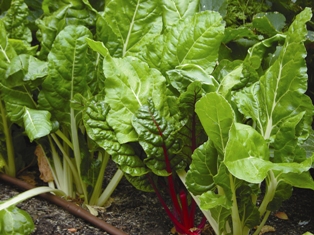Beta vulgaris L. Cicla
Time and space-poor gardeners might find vegetables that can be picked or cut continuously over time a better option than ‘once off’ crops. Silverbeet definitely measures up, and, it easy to grow and can be sown almost all year round in most regions. What more could you ask for!
Silverbeet is often called spinach but it’s not! They are both members of the same plant Family though…Amaranthaceae.
Silverbeet or Swiss chard, as it is also known, is actually a close relative of beetroot (in fact it’s a variety of the same species), but it’s grown for its leaves and stems.
Interestingly, in the United States and Australia the leaves are valued, while European cooks value the stalks. In fact they often discard the leaves or feed them to animals. The first varieties have been traced back to Sicily, rather than Switzerland!
Silverbeet seems to be more popular than spinach in Australia. Silverbeet is a cool climate plant that grows just as well in warmer climatic zones. In warm northern areas it can be sown almost all year, whereas in cold districts it is sown from early spring to early autumn.
Planting Schedule
Warm Areas: All year, except for the tropics where April – July are best
Temperate Areas: September – May
Cool to Cold Areas: September – March
Sowing Seed
It’s best to sow silverbeet seed direct where they are to grow. Rows should be about 500mm apart, and plants thinned to about 250mm between plants to allow mature growth. (Young silverbeet is an excellent salad vegetable as it has yet to develop the bitter taste of older plants).
Seed is best soaked for a few hours before sowing. Sow seed about 12mm deep.
Seeds take about 10 to 14 days to germinate, and thinning can commence when about 100mm tall.
Silverbeet prefers a slightly alkaline soil with at least a pH of 6 or above, and like all vegetables, needs well-drained, well composted soil that has the addition of animal manures.
Pests and Diseases
Apart from the usual problems associated with growing from seed (refer to the information sheet on Growing from Seed, silverbeet doesn’t really suffer pest and disease problems. Snails and slugs will of course enjoy young plants.

Harvesting
Silverbeet is the ultimate pick and eat plant, just take the leave you need and the plant will keep producing more leaves. Many leaves can be harvested at once without detriment to the plant because the roots store plenty of the carbohydrates necessary for additional leaf growth (and because older plants have larger roots, they can be quite denuded of leaves without a problem).
Varieties
The Seed Savers organisation lists about 12 different varieties of silverbeet. ‘Fordhook Giant’ is by far the most popular home garden variety for both its quality and high yield.
Diggers Seeds has developed Five Colour Mix, also known as Rainbow Chard, which is now very popular because of the variety of colours. (It also won an award!). The mix produces five different colour types, but in actual fact, the variation can be even more than just five. Rainbow Chard tends to be milder in flavour but just as productive as ‘Fordhook Giant’.
There are many other varieties available.
Information sources:
Yates Garden Guide, 42nd Edition, 2006, published by Harper Collins Publishers.
Blazey, C., The Australian Vegetable Garden, 2001, published by New Holland Publishers.
Related Articles:
Garden Journaling – Slow down to tune in.
As we move through the year and our gardens evolve, there's something magical about documenting the journey. Garden journaling is an art that enables…
The Importance of building soil health for a biodeverse, productive garden
Creating a thriving garden that not only sustains itself but also contributes to the broader ecosystem requires more than just sunlight and water.…



